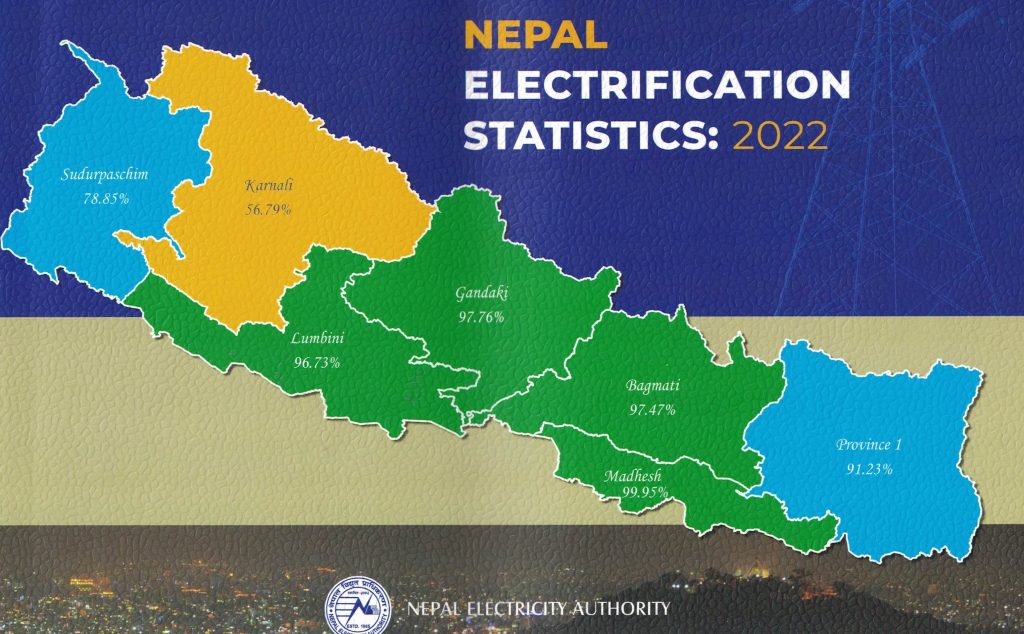KATHMANDU: Out of 753 local levels in Nepal, only 476 have been fully electrified. 242 local levels have been partially electrified, while Nepal Electricity Authority has not been able to supply electricity to 35 local levels.
According to the Electrification Statistics 2079 prepared by the authority after a detailed study of rural villages and municipal wards across the country, 92.51 percent of the total population has access to electricity. Among those who have access to electricity, 92.37 percent got electricity from the national grid and 0.14 percent from outside the grid.
Madhesh province has the highest electrification rate of 99.95% and Karnali province has the lowest electrification rate of 56.79%. According to the Nepal Electricity Authority, 91.23 percent in Province 1, 97.47 in Wagmati, 97.76 in Gandaki, 96.73 in Lumbini and 78.85 percent in Sudurpaschim Province. Out of 77 districts, 42 districts have been fully electrified.
Jhapa, Morang, Sunsari, Dhankuta, Saptari, Siraha, Dhanusha, Mahottari, Sarlahi, Rautahat, Bara, Parsa, Ramechhap, Dolakha, Kavrepalanchok, Sindhupalchok, Kathmandu, Bhaktapur and Lalitpur are basically electrified districts.
Similarly, Nuwakot, Rasuwa, Dhading, Chitwan, Tanahun, Lamjung, Kaski, Syangja, Palpa, Parbat, Mustang, Baglung, Gulmi, Pyuthan, Nawalparasi (East of Bardghat Susta), Nawalparasi, Rupandehi, Arghakhanchi, Kapilvastu, Dang, Banke, Bardia. , Kailali, Kanchanpur has basically been electrified.
75 to 95 percent electrification has been done in 14 districts namely Ilam, Panchthar, Tehrathum, Sankhuwasabha, Khotang, Udaipur, Sindhuli, Makwanpur, Gorkha, Palpa, Myagdi, Rukumpaschim, Doti and Dadeldhura. Taplejung, Bhojpur, Okhaldhunga, Manang, Rolpa, Salyan, Surkhet, Dailekh, Acham and Darchula have 50 to 75 percent electrification.
7 districts namely Rukumpur, Jumla, Kalikot, Mugu, Humla, Bajhang and Baitadi are only 25 to 50 percent electrified districts. Only 0 to 25 percent electrification has been done in 4 districts namely Solukhumbu, Dolpa, Jajarkot and Bajura. National grid has not yet reached Dolpa, Mugu and Humla.
The government has a program to electrify the places where the national transmission line cannot be reached through the alternative energy promotion center through solar, micro-hydro, etc.
Kulman Ghising, executive director of the authority, said that within the next two years (year 2024), work is being done in a planned manner to fulfill the announcement of the government of Nepal to provide reliable and quality electricity service to all Nepali people.
“In the financial year 2072/73, only 62.16 percent of households were electrified, but now it has reached 92.51 percent, 4 out of 7 provinces have been fully electrified”, he said, “Due to geographical difficulties and difficulties, there is some delay in electrification in the districts of Karnali Province. Even now, within two years, work is being done with high priority to provide electricity to everyone’s households, for this, we have managed the budget and called for tenders for the selection of construction professionals, he said.
The authority is electrifying the hilly districts of Lumbini, Karnali and Sudurpaschim by taking concessional loans of 220 million US dollars (about 28 billion rupees) from the Asian Infrastructure Investment Bank (AIIB) and the European Investment Bank (EIB).
Executive Director Ghising mentioned that the government’s investment and the authority have set aside a portion of the profit they have earned to expand access to electricity in other areas.
Manoj Silwal, the Deputy Executive Director of the Authority’s Distribution and Customer Service Directorate, said that despite the impact of the Covid-19 epidemic, the increase in the price of construction materials and equipment, and the globally damaged supply chain, 10 more districts could be basically electrified last year.
He said, “We have gone through the tender process to electrify the local levels that have been partially electrified and those that have not been electrified.”

